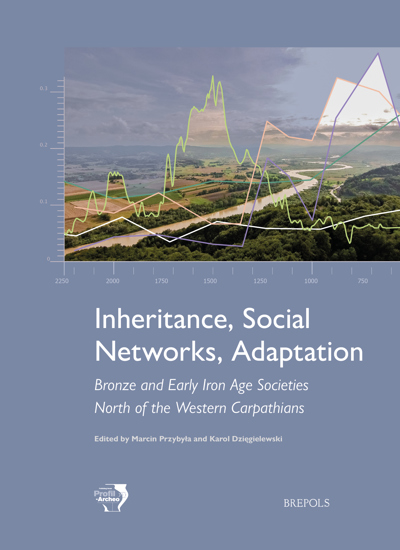
- Pages: 424 p.
- Size:216 x 280 mm
- Illustrations:3 b/w, 285 col., 11 tables b/w.
- Language(s):English
- Publication Year:2025
- € 85,00 EXCL. VAT RETAIL PRICE
- ISBN: 978-2-503-61687-2
- Hardback
- Available
- ISBN: 978-2-503-61688-9
- E-book
- Available
A beautifully illustrated and insightful volume that introduces the lost world of Roman Tongeren and its writing tablets to professionals and the general public alike
Edited by Else Hartoch and with contributions by Blänsdorf J., Scholz M., Accardo S., Boudin M., Deforce K., De Vos D., Groetembril S., Hameeuw H., Hartoch E., Marquez C., Pauwels D., Raepsaet G., Raepsaet-Charlier M.-Th., Vanderhoeven A., Van Kersen V., Verbanck-Piérard A. & Watteeuw L.
Roman wooden writing tablets, known in Latin as tabulae ceratae, have been found by archaeologists in various locations around the former capital of the civitas/municipium Tungrorum or Roman Tongeren (now the Belgian city of Tongeren-Borgloon). These rare and delicate finds are remarkable not only due to the excellent state of their preservation, but also because they are inscribed with the remnants of texts, once etched into an overlying wax layer, that can, to the discerning eye, still be deciphered. The tablets not only provide concrete information about religious, judicial and administrative practices, but they also enhance our understanding of the complex processes of Romanisation and Latinisation in the northwestern civitates and municipia of the Roman Empire.
Unearthed in the first half of the twentieth century, with a second group discovered in 2013, the Roman tablets housed in the Gallo-Roman Museum of Tongeren-Borgloon and in the city’s municipal heritage depository, became the object of an in-depth study by an international team of specialists piloted by the Gallo-Roman Museum. It is the results of this project that are presented here in this volume for the first time. The painstaking process of deciphering and interpreting the script marks and text fragments is explored via analysis of palaeography, philology and onomastics, along with key scientific techniques such as wax analysis, wood species identification, and script visualisation by Multi-Light Reflectance Imaging. Rich detail is also provided about other associated wooden finds that shed light on how and where the tablets were produced.
The result is a beautifully illustrated and insightful volume that introduces the lost world of Roman Tongeren and its writing tablets to professionals and the general public alike.
Acknowledgements
Part I The research project
1.1. Introduction: The project
Else Hartoch
1.2. The texts of the Tongeren tablets and their significance
Jürgen Blänsdorf and Markus Scholz
1.3. Wood use, production of writing tablets, and some associated finds
Koen Deforce, Else Hartoch, and Veerle van Kersen
1.4. Imaging incised stylus text marks on the Roman wooden writing tabletsof Tongeren using Multi-Light Reflectance technology
Lieve Watteeuw and Hendrik Hameeuw
1.5. Gas chromatography–mass spectrometry characterisation ofwax residues in wooden Roman writing tablets
Carlos Marquez, Sabina Accardo, and Dirk De Vos
1.6. Radiocarbon dating of the wooden tablets
Mathieu Boudin
Part II Historical and archaeological context of the tablets
2.1. To write and read, count and record, certify and attest:The multiple functions of tablets in Greek and Roman Antiquity
Annie Verbanck-Piérard
2.2. Atuatuca Tungrorum: A brief introduction
Alain Vanderhoeven
2.3 The Roman wooden writing tablets of Tongeren: Contextualising the finds
Dirk Pauwels
2.4. A painting of an aristocrat from Roman Tongeren carrying writing tablets
Sabine Groetembril
Part III Catalogue
3.1. A reader’s guideElse Hartoch
3.2. Catalogue Part 1Tablets with legible writing, symbols and/or illegible stylus marks
Jürgen Blänsdorf, Markus Scholz, Else Hartoch, Koen Deforce,Dirk Pauwels, Lieve Watteeuw, Hendrik Hameeuw, and Mathieu Boudin
3.3. Catalogue Part 2Tablets without legible writing, symbols and/or illegible stylus marks
Else Hartoch, Koen Deforce, Dirk Pauwels, Jürgen Blänsdorf,Markus Scholz, Lieve Watteeuw, Hendrik Hameeuw, and Mathieu Boudin
3.4. Catalogue Part 3
Production evidence and production waste
Else Hartoch, Koen Deforce, and Dirk Pauwels
3.5. Catalogue Part 4
Possible wooden writing equipment
Else Hartoch, Koen Deforce, Dirk Pauwels, and Veerle van Kersen
3.6. Catalogue Part 5
Miscellaneous wooden finds: mouldings
Else Hartoch, Koen Deforce, and Dirk Pauwels
Part IV Reflexions
4. General interpretations. The contribution of the Tongeren tablets to knowledgeof the institutions of the civitas/municipium Tungrorum and a problem statementconcerning the Romanisation and the Latinisation of the city and its region
Marie-Thérèse Raepsaet-Charlier and Georges Raepsaet
5. Conclusion
Else Hartoch
6. Appendices
Else Hartoch and Annie Verbanck-Piérard
6.1. Table listing the catalogue numbers of the wooden artefacts,their respective inventory numbers and their section in the catalogue
6.2. Table listing the wood species, site, and types of tablets
6.3. Table listing the dimensions (mm) of the writing tablets accordingto their wood species and site
6.4. Table listing the inventory number, category, and wood species of theitems linked to woodworking not included in part 3 of the catalogue
6.5. Index of personal names (praenomina, nomina and cognomina)attested by the Tongeren tablets
7. Notes on the contributors



